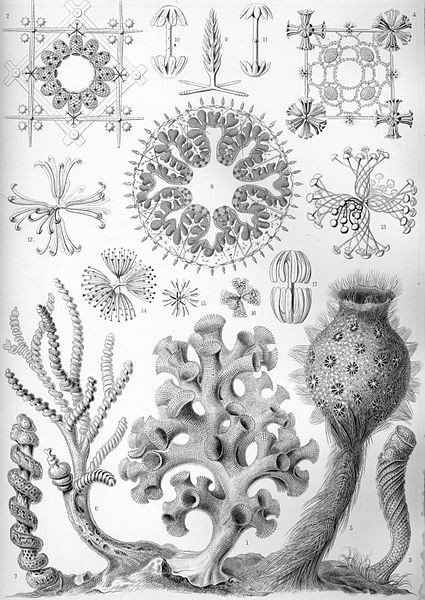There are three main types of sponges--calcareous, glass, and desmosponges. Taxonomists group sponges according to their skeletons. Sponge skeletons are not very similar to rigid human skeletons; they are flexible, elastic, and expansive.
Some sponges have spicules, which are tiny needle-like structures, embedded within their mesohyl. The class the sponge is grouped into is determined by the material the spicules are composed of.
In the activity below, click each tab to learn about the skeleton of each type of sponge.
Calcareous Sponges
Glass Sponges
Demosponges
![By Philippe Bourjon (Don de l'auteur) [CC-BY-SA-3.0 (http://creativecommons.org/licenses/by-sa/3.0)], via Wikimedia Commons](https://s3.amazonaws.com/cms.accelerate-ed.com/image/c8351875-933e-4307-9267-63e19cd79118.jpg)
Calcareous sponges, like the one pictured, contain spicules of the hard mineral calcium carbonate. They are the smallest of the sponges.
![By dphershman (Cloud Sponges) [CC-BY-2.0 (http://creativecommons.org/licenses/by/2.0)], via Wikimedia Commons](https://s3.amazonaws.com/cms.accelerate-ed.com/image/743d6fc1-e0fc-45ab-893d-d07598e98d2d.jpg)

Sponges in the class Hexactinelid are called glass sponges. Glass sponges have spicules composed of silica, which is a material that's similar to glass. The bright yellow sponge pictured is a glass sponge. Note the shiny texture of the sponge--this is the silica. Because glass sponges are delicate like glass, they live very deep in the ocean, avoiding the destructive currents. Also pictured are drawings of these delicate and elegant animals.
![By Parent Géry. (Own work.) [CC-BY-SA-3.0 (http://creativecommons.org/licenses/by-sa/3.0) or GFDL (http://www.gnu.org/copyleft/fdl.html)], via Wikimedia Commons](https://s3.amazonaws.com/cms.accelerate-ed.com/image/082db7c1-4faf-4604-8fac-ee25926a9f9c.jpg)
![By Philippe Bourjon (Don de l'auteur) [CC-BY-SA-3.0 (http://creativecommons.org/licenses/by-sa/3.0)], via Wikimedia Commons](https://s3.amazonaws.com/cms.accelerate-ed.com/image/99a20018-e9bf-4115-b9c6-ecd0966a4eb5.jpg)
Demosponges, such as the ones pictured, are the largest and most common of all sponges. About ninety percent of all sponges are demosponges. Demosponges have a skeleton made up of spongin, which is a flexible protein fiber. Some demosponges also contain spicules of both silica and calcium carbonate.
In the activity below, match the word or phrase on the left with its definition on the right by dragging the corresponding circles.
|
spongin
|
flexible protein
calcium carbonate spicule
silica spicule
|
|
spicule
|
flexible protein
type of sponge
tiny needle
|
|
silica spicule
|
found only in demosponges
found in calcareous sponges
found mostly in glass sponges
|
|
calcareous sponges
|
have calcium carbonate spicules
have silica spicules
have a skeleton made of spongin
|
Complete
